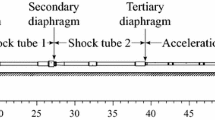Abstract
This paper presents the second part of a study aiming to accurately characterise a Mach 10 scramjet test flow generated using a large free-piston-driven expansion tube. Part 1 described the experimental set-up, the quasi-one-dimensional simulation of the full facility, and the hybrid analysis technique used to compute the nozzle exit test flow properties. The second stage of the hybrid analysis applies the computed 1-D shock tube flow history as an inflow to a high-fidelity two-dimensional-axisymmetric analysis of the acceleration tube. The acceleration tube exit flow history is then applied as an inflow to a further refined axisymmetric nozzle model, providing the final nozzle exit test flow properties and thereby completing the analysis. This paper presents the results of the axisymmetric analyses. These simulations are shown to closely reproduce experimentally measured shock speeds and acceleration tube static pressure histories, as well as nozzle centreline static and impact pressure histories. The hybrid scheme less successfully predicts the diameter of the core test flow; however, this property is readily measured through experimental pitot surveys. In combination, the full test flow history can be accurately determined.






















Similar content being viewed by others
References
Gildfind, D.E., Jacobs, P.A., Morgan, R.G., Chan, W.Y.K., Gollan, R.J.: Scramjet test flow reconstruction for a large-scale expansion tube, Part 1: quasi-one-dimensional modelling. Shock Waves. https://doi.org/10.1007/s00193-017-0785-x
Gildfind, D.E., Morgan, R.G., Jacobs, P.A.: Expansion tubes in Australia. In: Igra, O., Seiler, F. (eds.) Experimental Methods of Shock Wave Research. Shock Wave Science and Technology Reference Library, vol. 9, pp. 399–431. Springer, Cham (2016). https://doi.org/10.1007/978-3-319-23745-9_13
Toniato, P., Gildfind, D., Jacobs, P., Morgan, R.: Current progress of the development of a Mach 12 scramjet operating condition in the X3 expansion tube. In: Proceedings of the 20th Australasian Fluid Mechanics Conference, Perth, Australia, Dec 5–8 (2016)
Jacobs, P.: Quasi-one-dimensional modelling of a free-piston shock tunnel. AIAA J. 32(1), 137–145 (1994). https://doi.org/10.2514/3.11961
Gollan, R., Jacobs, P.: About the formulation, verification and validation of the hypersonic flow solver Eilmer. Int. J. Numer. Methods Fluids 73, 19–57 (2013). https://doi.org/10.1002/fld.3790
The compressible-flow CFD project. Available from http://cfcfd.mechmining.uq.edu.au/
Gordon, S., McBride, B.: Computer program for complex chemical equilibrium compositions and applications. NASA RP-1311 (1994)
Mirels, H.: Shock tube test time limitation due to turbulent-wall boundary layer. AIAA J. 2(1), 84–93 (1963). https://doi.org/10.2514/3.2218
Gildfind, D.: Development of high total pressure scramjet flow conditions using the X2 expansion tube. Ph.D. Thesis, School of Mechanical and Mining Engineering, The University of Queensland, Brisbane (2012)
Mirels, H.: Test time in low-pressure shock tubes. Phys. Fluids 6(9), 1201–1214 (1963). https://doi.org/10.1063/1.1706887
Duff, R.: Shock-tube performance at low initial pressure. Phys. Fluids 2(2), 207–216 (1959). https://doi.org/10.1063/1.1705910
Moore, J.A.: Description and initial operating performance of the Langley 6-inch expansion tube using heated helium driver gas. NASA TM X-3240, NASA Langley Research Center, Hampton, VA (1975)
Laney, C.C. Jr.: Microwave interferometry technique for obtaining gas interface velocity measurements in an expansion tube facility. NASA TM X-72625, NASA Langley Research Center, Hampton, VA (1974)
Shinn, J.L., Miller, C.G. III: Experimental perfect-gas study of expansion-tube flow characteristics. NASA Technical Paper 1317, NASA Langley Research Center, Hampton, VA (1977)
Tu, J., Yeoh, G.H., Liu, C.: Computational Fluid Dynamics: A Practical Approach, 1st edn. Elsevier, Amsterdam (2008). https://doi.org/10.1016/B978-075068563-4.50001-X
Smith, C.E.: The starting process in a hypersonic nozzle. J. Fluid Mech. 24, 625–640 (1966). https://doi.org/10.1017/S0022112066000880
Bakos, R., Erdos, J.: Options for enhancement of the performance of shock-expansion tubes and tunnels. In: Proceedings of the 33rd Aerospace Sciences Meeting and Exhibit, Reno, NV, Jan 9–12, AIAA Paper 1995-0799 (1995). https://doi.org/10.2514/6.1995-799
Bakos, R., Castrogiocanni, A., Calleja, J., Nucci, L., Erdos, J.: Expansion of the Scramjet ground test envelope of the HYPULSE facility. In: Proceedings of the 7th International Space Planes and Hypersonic Systems and Technologies Conference, Norfolk, VA, Nov 18–22, AIAA Paper 1996-4506 (1996). https://doi.org/10.2514/6.1996-4506
Gildfind, D., Morgan, R., McGilvray, M., Jacobs, P.: Production of high Mach number scramjet flow conditions in an expansion tube. AIAA J. 52(1), 162–177 (2014). https://doi.org/10.2514/1.J052383
McGilvray, M., Morgan, R., Jacobs, P.: Scramjet experiments in an expansion tunnel: evaluated using a quasi-steady analysis technique. AIAA J. 48(8), 1635–1646 (2010). https://doi.org/10.2514/1.J050024
Acknowledgements
The authors wish to thank Frans De Beurs, Neil Duncan, and the EAIT Faculty Workshop, for technical assistance with X3; the Australian Research Council for support and funding; the Queensland Smart State Research Facilities Fund 2005 for support and funding; the Australian Space Research Program and UQ for their funding in support of the “Scramjet-based Access-to-Space Systems” (SCRAMSPACE) project; and the UQ High Performance Computing (HPC) Support Group for supercomputing support; this work was supported by computational resources provided by the Australian Government through Raijin and Magnus under the National Computational Merit Allocation Scheme.
Author information
Authors and Affiliations
Corresponding author
Additional information
Communicated by Z. Jiang and A. Higgins.
Rights and permissions
About this article
Cite this article
Gildfind, D.E., Jacobs, P.A., Morgan, R.G. et al. Scramjet test flow reconstruction for a large-scale expansion tube, Part 2: axisymmetric CFD analysis. Shock Waves 28, 899–918 (2018). https://doi.org/10.1007/s00193-017-0786-9
Received:
Revised:
Accepted:
Published:
Issue Date:
DOI: https://doi.org/10.1007/s00193-017-0786-9




